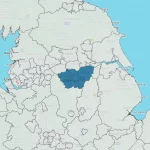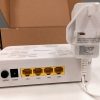Openreach Trial Use of UK Broadband Network to Detect Gas and Water Leaks

Network access provider Openreach (BT) has joined with a number of major new partners, including Arcadis, Thames Water, Cadent, Affinity Water and Lightsonic, to trial a couple of different approaches for detecting mains water and gas leaks, which cleverly works by harnessing the operator’s existing fibre optic broadband network.
The idea of using optical fibre cables, which transmit data using pulses of laser light, to detect and monitor nearby events is nothing new. For example, scientists have already found ways of turning such cables into Earthquake and Tsunami monitors (here and here), which works by detecting changes in the polarization of light as it moves through the cable. We’ve also seen fibre sensing technologies being adapted to detect sabotage against vital subsea cables (here).
Suffice to say that fibre optic sensing technologies have come a long way and they’re continuing to improve, which is likely to offer some new and increasingly interesting opportunities for existing broadband operators. Naturally, any operator with a network the size of Openreach’s is a prime candidate for such things, particularly if it can be successfully adapted to help identify and locate water and gas leaks.
Advertisement
In order to test this, Openreach appears to have engaged with a couple of different trials.
The First Trial
The first one reflects a partnership with Arcadis, Thames Water and Cadent, which will adopt Distributed Acoustic Sensing (DAS) from FiberSense. The technology converts “spare” fibre optic cables into early warning sensors that can “hear and accurately pin-point problems” across surrounding gas and water networks. The trial will run for 6-months in Hounslow (West London) and is being funded by Transport for London’s (TfL) Lane Rental Scheme.
Just to be clear, DAS works by detecting changes in the light signal used in fibre optic cables caused by vibrations, such as those emanating from a sudden blockage or leak in surrounding networks, or simply a developer digging in the wrong place. Machine learning is used to locate the exact point of the vibration and train the system to separate background noise – such as a passing car or underground train – from specific events like a leak.
A key aim of the project is to detect problems early to allow quick intervention and thereby reduce the disruption of emergency or unplanned street works (i.e. the ability to quickly schedule repair work outside of busy hours or at the weekend can save time and money), which currently costs the capital an estimated £750m every year (economic and social impact).
Advertisement
Sam Bright, Innovation Manager for Thames Water, said:
“Openreach were the obvious choice of telecoms partner for this project. We want to create a model that can be adopted in other UK cities, not just in London. Openreach have the national reach we wanted.”
This model could be useful to all UK water companies and the same goes for the gas and telecoms providers around the country.”
Trevor Linney, Director of Network Technology for Openreach, said:
“Openreach is constantly looking at leveraging new technology and innovation to improve the resilience and efficiency of our network, and by testing the use of fibre sensing technology in this way – we hope to prove that we can do that, for the networks of other utility providers– with the potential to offer this service across the UK.”
The key challenge above is in adapting the technology to work for a scale deployment, which as above will initially harness spare fibres in Openreach’s network to deliver one sensing network capable of providing real-time data for multiple utilities, allowing costs to be shared. “Further savings would come from making use of the extensive fibre network already built by Openreach, rather than having to install a dedicated sensing fibre network,” said the announcement.
If the trial goes well then the plan is to expand it into a London-wide pilot, which would make it the first city in the world to have effectively an underground early warning radar system of this type.
The Second Trial
Openreach has separately teamed up with Affinity Water and Lightsonic to deploy Distributed Fibre Optic Sensing (DFOS) leak detection technology into their existing fibre network. Every day, the UK loses approximately 3 billion litres of treated water, which represents nearly a quarter of the country’s water supply, highlighting the urgent need for action. But this could help to tackle that.
Similar to the above approach, Lightsonic is piloting the use of DFOS to convert Openreach’s fibre optic cables into thousands of virtual sensors, which can allegedly detect the unique acoustic signatures of leaking water with “pinpoint accuracy“. Machine learning algorithms then filter out background noise (e.g. road traffic) to ensure reliable, real-time alerts.
Advertisement
The approach of using Openreach’s network is said to make all this “significantly faster at detecting leaks, more scalable, and more cost-effective“.
James Curtis, Head of Leakage at Affinity Water, said:
“This is a transformative moment for our leakage strategy. By harnessing Lightsonic’s advanced fibre optic sensing technology and Openreach’s extensive network, we’re unlocking a new era of proactive leak detection. This will help us meet our ambitious leakage reduction targets and deliver a more resilient service to our customers.”
The second trial doesn’t include a lot of detail, but both trials represent a potentially very significant development that could have a major impact upon such leaks in the future. On the other hand, we’ve never seen such methods deployed at scale within an existing UK network like Openreach’s, and it remains to be seen how successful they are in delivering on what has been promised.
However, it’s worth remembering that Openreach aren’t the only fibre game in town, and it’s possible that we might even see rival networks – belonging to several different operators – being harnessed in the future in order to further improve such systems. But for now it’s wise to focus on a single network and Openreach, as the biggest FTTP provider, is indeed the logical choice.
We hope to catch up with the progress of these trials sometime early next year.
Mark is a professional technology writer, IT consultant and computer engineer from Dorset (England), he also founded ISPreview in 1999 and enjoys analysing the latest telecoms and broadband developments. Find me on X (Twitter), Mastodon, Facebook, BlueSky, Threads.net and Linkedin.






















































So would this technology negate the need to install more infrastructure ( by telegraph poles) to house the LORaWAN equipment to read smart water meters . Connexin is installing these telegraph poles for several different water companies . Water companies state the reason this infrastructure is required is to identify leaks early but surely this would only identify domestic leaks which you would hope most households would respond to quickly anyway . It has been reported that the smart water meters will rather identify high end users of water and might lead to a two level charging system
Thought people with water meters were charged by usage anyway. As they should be, it’s not an unlimited resource.
This isn’t related to smart metering really. The leaks the meters would notice are between meter and property. This would be best for before the fibre is split so likely next to the bigger mains.
Once it’s split you know the distance but would have to check every branch.
No it could not be used for that. I was under the impression that most LoRaWAN receivers were going on existing mobile masts with existing masts, power and backhaul.
As for domestic leaks your toilet might have a low level leak that you would not notice but actually mounts up. A dripping tap can be anywhere from 2000 to 10000 litres a year.
Perhaps they should use it to detect petrol leaks at petrol stations ha ha.